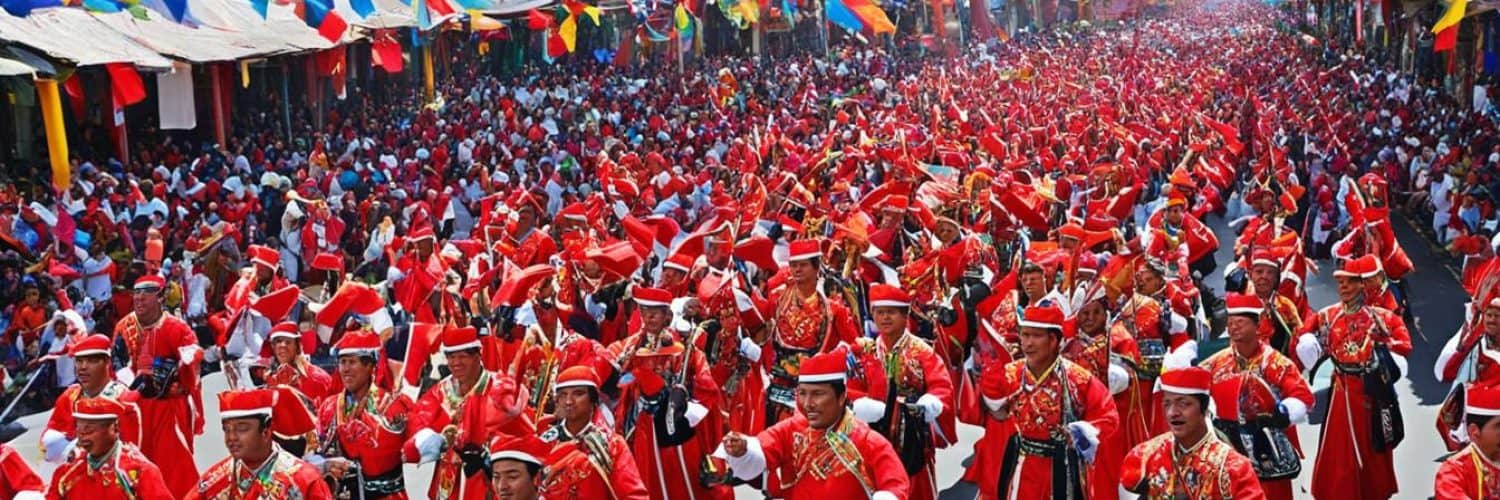Nestled in the heart of Laguna, Santa Rosa is a city that offers a truly unique experience for travelers seeking to immerse themselves in the charm and culture of the Philippines. With its rich history, diverse tourist attractions, and a vibrant atmosphere, Santa Rosa is a must-visit destination for those looking to explore the beauty of the Santa Rosa Laguna region.
As you navigate through the city, you’ll be captivated by the architectural wonders that tell the story of Santa Rosa’s evolution over time. From the remnants of Spanish colonial design to the influence of American and post-war styles, the architecture of Santa Rosa beautifully reflects the city’s journey through history.
Whether you’re exploring historical landmarks, indulging in delicious local cuisine, or immersing yourself in the natural beauty of the region, Santa Rosa offers a plethora of things to see and do. From vibrant city life to serene natural landscapes, this city has it all.
In this travel guide, we will take you on a journey through Santa Rosa’s architectural heritage, highlighting its unique blend of the past and the present. Discover the hidden gems, learn about the city’s rich history, and experience the warmth and hospitality of its people as you explore Santa Rosa.
Key Takeaways:
- Explore the architectural wonders that showcase Santa Rosa’s rich history and cultural evolution.
- Discover the Spanish colonial influences in structures such as the Santa Rosa de Lima Parish Church.
- Learn about the American and post-war architectural styles that have shaped the city.
- Experience the fusion of past and present in modern developments like the Paseo de Santa Rosa.
- Partake in the preservation efforts to maintain Santa Rosa’s architectural heritage.
The Spanish Influence in Santa Rosa’s Architecture
The architectural landscape of Santa Rosa bears witness to the strong Spanish influence that shaped the city’s design. From the grandeur of the Santa Rosa de Lima Parish Church to the charming details of old homes and buildings, the Spanish colonial design is evident throughout the city. The baroque style, popular during the Spanish era, is showcased in the exquisite architecture that still stands proudly today.
The Santa Rosa de Lima Parish Church, built in the 18th century, is a true masterpiece of colonial architecture. Its ornate facade, adorned with intricate details, and its towering belfry are iconic symbols of the city’s past. Stepping inside, one is transported back to the Spanish era, immersed in the rich history and cultural heritage that Santa Rosa holds dear.
“The Spanish influence is palpable in Santa Rosa’s architecture, showcasing the beauty of the baroque style. The Santa Rosa de Lima Parish Church stands as a testament to the city’s past, its exquisite design capturing the essence of the Spanish era.”
In addition to the church, Santa Rosa’s city center still proudly displays buildings and homes that bear the hallmarks of Spanish colonial design. The intricate details, arched windows, and picturesque courtyards all reflect the historical legacy of the Spanish era. These historical buildings serve as reminders of the city’s heritage and contribute to its unique charm.
The Santa Rosa de Lima Parish Church: A Baroque Masterpiece
| Architectural Features | Description |
|---|---|
| Facade | Elaborate carvings, intricate details, and statues of saints |
| Bell Tower | Towering structure with multiple levels and finely crafted bells |
| Interior | High ceilings, ornate altar, colorful stained glass windows |
The Santa Rosa de Lima Parish Church is a true architectural gem, exemplifying the baroque style prevalent during the Spanish era. Its grand facade, adorned with elaborate carvings and statues, captivates visitors and showcases the attention to detail of the period. The towering bell tower, with its intricately crafted bells, adds to the church’s magnificence.
Stepping inside, the grandeur continues, with high ceilings, an ornate altar, and vibrant stained glass windows. The interior of the church creates a solemn and awe-inspiring atmosphere, inviting visitors to appreciate the rich religious and cultural heritage of Santa Rosa.
The American and Post-War Influence in Santa Rosa’s Architecture
During the American occupation, Santa Rosa’s architecture experienced a significant evolution, incorporating elements of American colonial design. The introduction of American-style homes with wide porches and open spaces became popular, reflecting a more relaxed and informal lifestyle. This transition marked a departure from the traditional Spanish colonial design and a shift towards a more contemporary aesthetic.
The neoclassical style also gained prominence during this period, with public buildings being designed in this architectural language. Neoclassical structures featured grand facades, symmetrical designs, and ornate details inspired by classical Greek and Roman architecture. These buildings became landmarks of the city and exemplified the influence of the American era on Santa Rosa’s architectural landscape.
With the end of World War II, Santa Rosa experienced a rapid period of growth and expansion. The post-war influences brought about a building boom in the city, resulting in a blend of architectural styles from various periods. Modernist influences became prominent, emphasizing simplicity, functionality, and the use of new construction materials.
The post-war period brought about a shift towards a more modern style, characterized by the use of concrete and steel as primary construction materials. These materials allowed for the construction of taller structures and innovative designs that reflected the changing times. The combination of modernist influences with the existing architectural styles created a unique and diverse architectural landscape in Santa Rosa.
This era of architectural development showcased the city’s resilience and adaptability to change. Santa Rosa embraced the opportunities presented by the post-war period, resulting in a cityscape that honors its historical roots while embracing the advancements of modern architecture.
The Modern Landscape of Santa Rosa’s Architecture
Today, Santa Rosa embraces modernity while still honoring its architectural heritage. The city has welcomed modern developments, with sleek office buildings and contemporary homes. One notable example is the Paseo de Santa Rosa, a commercial complex that fuses past and present architectural elements. This balance between progress and heritage is a defining characteristic of Santa Rosa’s architecture.
Fusion of Past and Present
“Santa Rosa’s architecture beautifully combines the old and the new, creating a unique visual experience for residents and visitors alike. The fusion of past and present elements adds depth and richness to the city’s architectural landscape, reflecting its vibrant history and embracing its modern aspirations.” – Architect Maria Santos
Contemporary homes in Santa Rosa showcase cutting-edge designs while integrating aspects of traditional architecture. These homes are characterized by sleek lines, minimalist aesthetics, and innovative use of materials. They are a testament to the city’s commitment to progressive design while maintaining a connection to its cultural past.
The Paseo de Santa Rosa
An outstanding embodiment of the fusion between past and present is the Paseo de Santa Rosa. This dynamic commercial complex seamlessly integrates historical architectural elements into its modern structure. The Paseo de Santa Rosa stands as a symbol of Santa Rosa’s dedication to preserving its heritage while embracing progress.
Designed with a contemporary flair, the Paseo de Santa Rosa features sleek exteriors and state-of-the-art facilities. However, its design also incorporates traditional motifs and materials, paying homage to the city’s vibrant past. The result is a visually captivating space that seamlessly blends old and new, creating a unique atmosphere for shopping, dining, and entertainment.
As you explore the Paseo de Santa Rosa, you’ll come across charming courtyards adorned with colorful tiles, reminiscent of Spanish colonial architecture. The blend of modern construction techniques and traditional design elements creates an inviting environment where visitors can experience the fusion of past and present.
Appreciating the Contemporary Landscape
The modern landscape of Santa Rosa’s architecture is not solely limited to commercial developments. Contemporary residential buildings also play a significant role in shaping the city’s aesthetic. Sleek condominium complexes, thoughtfully designed with cutting-edge features and amenities, provide residents with comfortable and stylish living spaces.
| Key Features of Contemporary Homes in Santa Rosa | Benefits |
|---|---|
| Energy-efficient design | Reduced environmental impact and lower utility costs |
| Open floor plans | Enhanced spatial flow and flexibility in interior design |
| Sustainable materials | Minimized carbon footprint and healthier living environments |
| Smart home technology | Convenient and efficient management of various household functions |
The fusion of past and present in Santa Rosa’s architecture is a testament to the city’s commitment to preserving its cultural heritage. By embracing contemporary designs while incorporating historical elements, Santa Rosa creates a unique architectural landscape that reflects its rich history and paves the way for a progressive future.
Notable Historical Landmarks in Santa Rosa
Santa Rosa, a city steeped in history and culture, boasts several remarkable historical landmarks that are not to be missed. These architectural gems are a testament to the city’s rich heritage and offer visitors a glimpse into its past.
Santa Rosa de Lima Parish Church
One of the most iconic landmarks in Santa Rosa is the Santa Rosa de Lima Parish Church. This exquisite colonial church, with its ornate façade and towering belfry, showcases the splendor of Spanish colonial architecture. Visitors will be captivated by the intricate details and the grandeur of this historical masterpiece. Stepping inside, one can’t help but be in awe of the sacred ambiance that envelops the church.
Santa Rosa City Museum
The Santa Rosa City Museum, housed in a heritage building, offers a fascinating journey through the city’s history. Exhibits and artifacts provide valuable insights into Santa Rosa’s evolution over the years, from its early settlement to its development into a bustling city. The museum’s carefully curated displays and informative exhibits make it a must-visit for history enthusiasts and curious travelers alike.
Santa Rosa City Hall
Standing as a symbol of Santa Rosa’s civic pride, the Santa Rosa City Hall is an impressive structure that showcases architectural excellence. Its design combines elements of the city’s history with modern influences, creating a harmonious blend of past and present. This iconic landmark is not only an administrative center but also a symbol of the city’s progress and development.
Visiting these historical landmarks in Santa Rosa is a journey through time, allowing visitors to appreciate the city’s rich heritage and cultural identity. Whether marveling at the colonial grandeur of the Santa Rosa de Lima Parish Church, delving into the city’s history at the Santa Rosa City Museum, or admiring the architectural brilliance of the Santa Rosa City Hall, each experience provides a deeper understanding of Santa Rosa’s past and its significance in the present.
Blending Modernity and Tradition in Santa Rosa
The Paseo de Santa Rosa perfectly exemplifies the city’s ability to seamlessly blend modernity and tradition in its architectural landscape. This vibrant commercial hub showcases modern Filipino architecture while paying homage to the city’s past, creating a fusion of the past and present that is both visually captivating and culturally significant.
The Paseo de Santa Rosa is a testament to the contemporary design trends that have emerged in the Philippines, reflecting the country’s rich architectural heritage while embracing the innovative spirit of the present. The fusion of traditional elements and modern aesthetics creates a unique setting that draws both locals and tourists, providing an immersive experience that highlights the evolution of Santa Rosa’s architectural identity.
One of the key features of the Paseo de Santa Rosa is its emphasis on modern Filipino architecture. This style incorporates elements from various architectural influences, such as Spanish colonial, American colonial, and post-war designs, resulting in a visually striking fusion of past and present. The incorporation of indigenous materials, traditional motifs, and contemporary design principles showcases the city’s commitment to preserving its cultural heritage while embracing progress.
“The Paseo de Santa Rosa stands as a testament to Santa Rosa’s evolving architectural identity. It beautifully captures the essence of modernity while acknowledging the importance of honoring the past. Its seamless integration of traditional and contemporary design elements makes it a must-visit destination for architecture enthusiasts and cultural explorers alike.” – Architect Maria Santos
Architecture that Inspires
The Paseo de Santa Rosa’s contemporary design and fusion of past and present elements serve as a source of inspiration for architects, designers, and urban planners. It exemplifies how a city can embrace modernity without losing sight of its cultural heritage, providing a roadmap for other urban centers seeking to create a harmonious balance between tradition and progress.
Not only does the Paseo de Santa Rosa’s architectural aesthetic visually engage visitors, but it also creates a sense of place and identity for the local community. The design elements and cultural references embedded within the structures connect residents to their roots while fostering a sense of pride and belonging.
Experience the Fusion
Visitors to Santa Rosa can immerse themselves in the fusion of past and present at the Paseo de Santa Rosa. Here, they can explore modern commercial spaces, indulge in the city’s vibrant culinary scene, and witness firsthand the harmonious coexistence of contemporary design and traditional elements.
As you stroll through the Paseo de Santa Rosa, you’ll be surrounded by architectural marvels that showcase the unique blend of modernity and tradition. From the sleek facades to the intricate details inspired by Filipino craftsmanship, every corner of this commercial complex tells a story of Santa Rosa’s architectural evolution.
Whether you’re a design enthusiast, a history buff, or simply looking to explore the charm of Santa Rosa, a visit to the Paseo de Santa Rosa is a must. Experience the fusion of past and present, and witness firsthand the remarkable synergy between modern Filipino architecture and the rich cultural heritage of this vibrant city.
Preservation of Santa Rosa’s Architectural Heritage
In Santa Rosa, the preservation of its architectural heritage holds great importance. The city recognizes the need to protect the historical buildings that stand as testimonies to its rich cultural history. With rapid development, it is crucial to ensure that these architectural treasures are not lost in the midst of progress.
Local initiatives have been put in place to restore and preserve the historical buildings of Santa Rosa. Through these efforts, the city aims to maintain its cultural identity and preserve the charm that these buildings bring. By safeguarding the architectural heritage, Santa Rosa continues to honor its past while embracing the present.
“Preserving historical buildings is not just about maintaining physical structures. It is about keeping alive the stories, traditions, and values that are embedded within them.” – Mayor Rodriguez
Restoration initiatives are carried out by experts in the field, ensuring that the historical buildings are treated with the utmost care and respect. These efforts involve meticulous research, sourcing of authentic materials, and skilled craftsmanship. Through restoration, the grandeur of Santa Rosa’s architectural gems is restored, allowing visitors to appreciate the intricate details and craftsmanship of bygone eras.
Santa Rosa’s commitment to preserving its architectural heritage serves as a reminder of the city’s dedication to its culture and history. It showcases a deep appreciation for the beauty and significance of historical buildings, which play a vital role in shaping the identity of the city.
Santa Rosa’s Architectural Evolution and Identity
Santa Rosa’s architectural evolution is a testament to the city’s rich history, vibrant culture, and distinct identity. The city has seen the transformation of its structures and buildings over time, with each era leaving a unique mark on its architectural landscape. From the remnants of Spanish colonial design to the influences of American and post-war styles, Santa Rosa’s architecture reflects its resilient spirit and ability to adapt to changing times.
The architectural journey of Santa Rosa begins with the Spanish colonial relics that still stand proudly in the city. These structures, such as the iconic Santa Rosa de Lima Parish Church, showcase the baroque style and serve as a reminder of the city’s colonial past.
As the American era took hold, Santa Rosa’s architecture embraced new influences. Neoclassical designs became prominent, and American-style homes with wide porches and open spaces dotted the cityscape. The post-war period brought about a wave of modernist influences, with concrete and steel shaping the architectural landscape.
Today, Santa Rosa’s skyline is adorned with modern structures that coexist harmoniously with its historical buildings. The city has seamlessly blended modern developments with its rich cultural heritage. This fusion of the past and the present creates a unique aesthetic that reflects Santa Rosa’s identity.
Each structure in Santa Rosa tells a story and contributes to the city’s overall narrative. From colonial churches to contemporary commercial hubs, the architectural evolution of Santa Rosa is a visual representation of its history and culture. It showcases the resilience and adaptability of the city, as it continues to grow while honoring its past.
By preserving its architectural heritage and incorporating modern design elements, Santa Rosa has found a way to capture its unique identity. The city’s architectural landscape is a reflection of its rich history, diverse culture, and the unwavering spirit of its residents.
Conclusion
In Santa Rosa, the architecture is more than just a collection of buildings. It is a reflection of the city’s charm and culture. From the elegant Spanish colonial influences to the sleek modern developments, Santa Rosa’s architectural landscape is a dynamic blend of the past and the present. This unique combination creates a vibrant and inviting city that continues to inspire and captivate both residents and visitors.
The architecture of Santa Rosa tells a story of the city’s rich history and cultural evolution. The Spanish colonial buildings with their baroque style stand as testaments to the city’s colonial past. The American and post-war influences brought neoclassical and modernist elements, shaping the city’s architectural identity.
Today, Santa Rosa embraces modernity while still honoring its architectural heritage. The fusion of past and present can be seen in the contemporary designs that coexist harmoniously with historical landmarks. One example is the Paseo de Santa Rosa, a commercial complex that seamlessly blends modern Filipino architecture with elements that pay homage to the city’s past.
In preserving its architectural heritage, Santa Rosa ensures that its rich cultural identity is maintained. Restoration initiatives and local efforts to protect historical buildings showcase the city’s commitment to preserving its unique architectural landscape. As Santa Rosa continues to evolve, its architecture will continue to serve as a symbol of its resilience and adaptability, making it a must-visit destination for anyone seeking a glimpse into the vibrant culture and charm of the Philippines.
FAQ
What is the charm of Santa Rosa, Philippines?
Santa Rosa is a city that has undergone a remarkable transformation over the years. Its architecture reflects its rich history and cultural evolution, from its Spanish colonial past to its modern-day landscape. The blend of old and new creates a unique charm that captivates visitors.
What are some tourist attractions in Santa Rosa, Laguna?
Some of the notable tourist attractions in Santa Rosa include the Santa Rosa de Lima Parish Church, the Santa Rosa City Museum, and the Santa Rosa City Hall. These landmarks showcase the architectural heritage and historical significance of the city.
What architectural styles can be found in Santa Rosa?
Santa Rosa is a melting pot of architectural styles. The city’s architecture exhibits Spanish colonial design, American colonial influences, post-war styles, and modern developments. The fusion of these different styles creates a diverse and captivating architectural landscape.
What is the significance of the Santa Rosa de Lima Parish Church?
The Santa Rosa de Lima Parish Church is a significant historical landmark in Santa Rosa. Built in the 18th century, it showcases the baroque style prevalent during the Spanish era. The church’s ornate facade and towering belfry make it a must-visit for architecture enthusiasts.
How does Santa Rosa blend modernity and tradition in its architecture?
Santa Rosa embraces modernity while still honoring its architectural heritage. The city features modern developments such as sleek office buildings and contemporary homes. The Paseo de Santa Rosa, for example, fuses past and present architectural elements, creating a unique aesthetic that captivates locals and tourists alike.
What is being done to preserve Santa Rosa’s architectural heritage?
Santa Rosa recognizes the importance of preserving its architectural heritage. Local initiatives are in place to restore and preserve historical buildings, ensuring that the city’s rich architectural history is not lost amidst its rapid development. These efforts demonstrate the city’s commitment to maintaining its cultural identity.
How does Santa Rosa’s architecture reflect its identity?
Santa Rosa’s architectural evolution tells the story of its history, culture, and identity. From the Spanish colonial relics to the American and post-war influences, and now the modern structures, each building contributes to the overall narrative of the city’s journey through time. Santa Rosa’s architecture reflects its resilience, adaptability, and its unique blend of the past and the present.


















Add comment